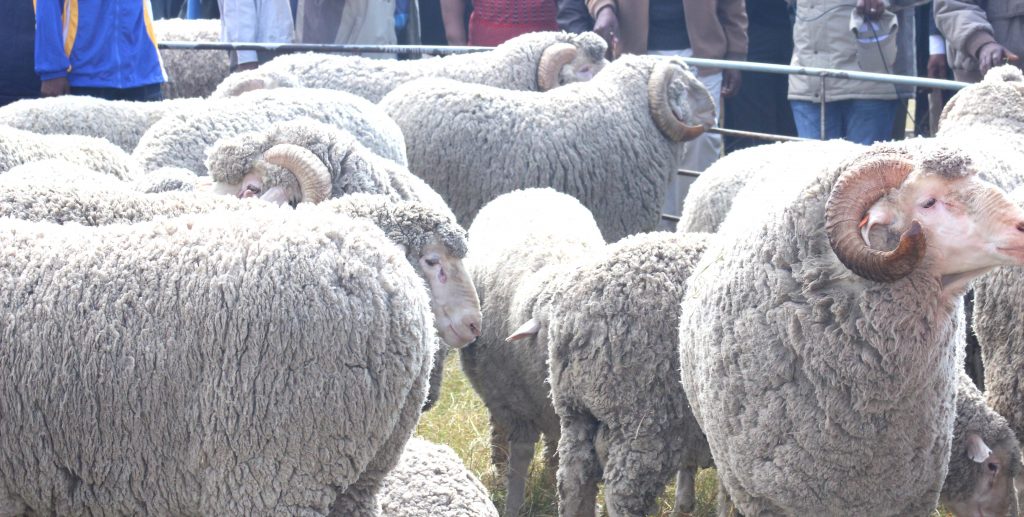
 THE wool and mohair farming sector has grown in leaps and bounds over the years. It entails rearing sheep and goats for their valuable wool and mohair coats.
THE wool and mohair farming sector has grown in leaps and bounds over the years. It entails rearing sheep and goats for their valuable wool and mohair coats.
The sector is among the highest contributors to the country’s agricultural output. In the 2015/16 financial year, the industry contributed approximately M380 million to the economy.
Currently, there is are an estimated 37 500 sheep and goat farmers who rear a combined estimated four million sheep and goats.
The farmers employ about 75 000 herd boys thus creating jobs for mostly illiterate people. The herd boys are often given animals as payment for their services and end up becoming farmers themselves.
Lesotho’s wool and mohair production for the 2015/16 financial year was estimated at four tonnes. The produce is predominately exported to South African, European and Asian markets.
With many people starting to take interest in the industry, Lesotho Times (LT) reporter Bereng Mpaki sat down with Mokuenihi Thinyane (TM), the president of the Lesotho National Wool and Mohair Growers Association — a network of sheep and goat farmers in the country, to find out more about the industry, especially with the advent of the shearing season.
LT: When is the right time to shear sheep and goats?
TM: It differs with the different districts of the country. The shearing season normally starts in August and continues in different districts to February of the following year.
LT: Why is it that the times differ from one district to another?
MT: Some districts start getting warmer earlier than others, so they are able to start the shearing process earlier. But those in the slower districts have to wait longer before starting the shearing process.
LT: Are there specific ways for preparing animals for shearing?
MT: Ideally, animals should be given good care of throughout the year and not only when the shearing season is approaching. This is because we are running a business which is producing according to the market preference.
Even after shearing, the animals should continue being given good care to ensure that come next shearing season they will be in a good condition to yield good products (wool and mohair).
LT: What should farmers do to give their animals the best care throughout the year?
MT: The animals should be medically treated to prevent and cure any diseases. It is also important for farmers to ensure they supplement the animals’ diet with mineral supplements during the winter seasons since there is less grazing in the rangeland.
Farmers are directly responsible for the amount of wool or mohair they collect during the shearing season and these are some of the things that will help them to get good yields.
LT: Is it advisable for the farmer to shear his own animals or should he engage the shearing shed?
MT: The shearing shed has professional shearers who are regularly trained to ensure they do it the right way to collect optimum coat from the animals so that the farmer also gets his year’s investment.
It is not an acceptable practice for a farmer to shear his own animals and then bring the coat to the shed. This is because we have to ensure that the coat that the farmer brings to the shed is indeed from his animals and not stolen.
And to be sure that the farmer is bringing his animals, we normally request that they bring along the animals’ registration identification.
LT: Are there enough shearing sheds around the country to accommodate all farmers’ animals?
MT: We have sheds countrywide and although there may be shortages here and there, they are insignificant. The government recently increased the number of sheds to address the problem.
We are also hopeful that the government project called WAMPP (Wool and Mohair Promotion Project) will include construction of new sheds to meet the demand.
LT: Who constructs and operates the sheds?
TM: The government normally helps us to construct the sheds. Once they are in place, it is the job of the LNWMGA to take over and operate the sheds and the equipment. People who work in the sheds are hired by the association.
LT: What does a shed need to be fully equipped for the task?
MT: There should be sorting tables for the coats, weighing scales, pressing machines (press), bale containers and fasters as well as recording books and pens. There should also be kraals for the animals for the duration of the shearing.
Workers are also required to carry out different jobs in the shed including sorting the coats, record keeping, pressers as well as providing security.
LT: What are common challenges in the process of shearing?
MT: Challenges include incorrect capturing of farmers’ particulars in the records which may result in the passing of wrong information to the person who is supposed to draw up a cheque after buying the coat.
It takes time to correct this because when it happens, the cheques have to be returned to Port Elizabeth (in South Africa).
Again, it may happen that when a farmer provides his banking details, these may not be captured correctly resulting in the money being deposited in the wrong account.
That recently happened to one Botha- Bothe based farmer whose money amounting to M70 000 was deposited into a wrong account, and the recipient only refunded M5 000.
We therefore prefer payments to be made via cheque rather than cash deposit because it is easier to return an incorrectly written cheque and correct it without losing any money.
LT: How long can the coats be stored before they lose their quality?
MT: Coats do not easily lose quality and that could only happen when they are not safely stored. However, we do not expect coats to stay in the shed for too long before going to the market. At most, the coats should be stored for two weeks and then shipped out so that they farmers can be paid as soon as possible.
That is why we usually transport the load immediately after we have collected enough coats to fill a truck.
LT: Please explain what happens to the coats after shearing.
MT: When the shearing has been completed the shed committee moves to preparing it by sorting, weighing and putting it in bales. It is then loaded into trucks and carried to LPMS where it is kept before being transported to Port Elizabeth to BKB, a company that we have engaged to help us sell the coats.
BKB first assesses the quality of the coats before grading it for the purposes of auctioning. This is where the value of the wool is determined.
LT: Please elaborate on the entire process of selling the coat.
MT: Many people mistakenly assume that BKB buys the coats from us, when we actually hired them to promote our coats. They assess and grade the coats. The amount of dirt in the coat determines the quality of the coat. BKB takes the coats to the exhibition shows where buyers will pick the grades of coats they desire.
LT: After the coats have been bought, how long does it take for farmers to receive the money from the sales?
MT: In a case where the farmer has opted to be paid through his bank account, this process takes a few days before the money can reflect in his account.
But in the case of a payment through cheque, the process takes a maximum of two weeks to reach LPMS in Lesotho, which then distributes the cheques to the farmers.
LT: What special characteristics do coats from Lesotho display at the point of sale?
MT: Our coats are preferred by most buyers in the market. However, due to the fact that our rangelands are rapidly being degraded, the quality of our animals is declining and that compromises the quality of our coats. The compromised coats easily pick up dirt and this tends to lower the grade of the coats on the market.
However, the buyers are able to use the dirt as manure while the grease from the coat is used for making cosmetics.
This is why we have been calling for establishment of a local scouring plant for our wool and mohair so that we can create jobs for our people.
LT: Why has that failed to happen?
MT: The Ministry of Trade and Industry commissioned a South African consultant to conduct a feasibility study on establishing the plant in 2005. Initially the plan was to have two consultants, one being a Mosotho but that did not materialise due to lack of funding from the ministry- a development we were never informed about.
So the South African consultant went ahead with the study and as we had predicted, his findings showed that Lesotho’s wool production capacity was not enough to warrant the establishment of the plant.
However, there has been talk in government in recent years to pursue the plant project. I am not sure at what stage that plan is at the moment.
LT: Are there any differences in the handling of sheep and goats during the shearing process?
MT: There is not much of a difference except that a goat is smaller than a sheep and therefore its coat is smaller.
LT: Which of wool and mohair has a higher unit value in the market?
MT: Mohair has higher unit value which can be enhanced if the farmer invests a lot of care in his animals to ensure they suit market needs. The unit value of mohair is almost twice that of wool.







